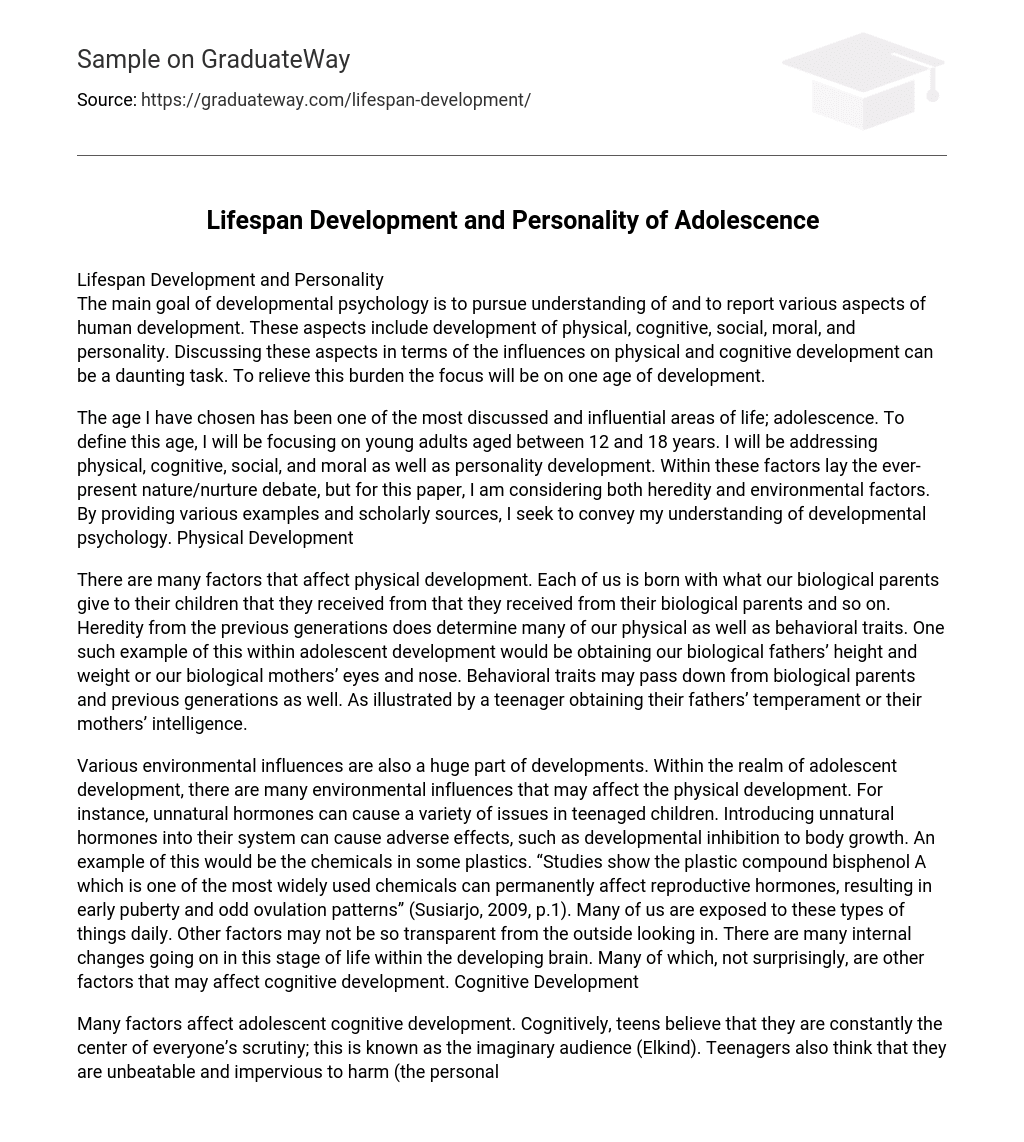Lifespan Development and Personality
The main goal of developmental psychology is to pursue understanding of and to report various aspects of human development. These aspects include development of physical, cognitive, social, moral, and personality. Discussing these aspects in terms of the influences on physical and cognitive development can be a daunting task. To relieve this burden the focus will be on one age of development.
The age I have chosen has been one of the most discussed and influential areas of life; adolescence. To define this age, I will be focusing on young adults aged between 12 and 18 years. I will be addressing physical, cognitive, social, and moral as well as personality development. Within these factors lay the ever-present nature/nurture debate, but for this paper, I am considering both heredity and environmental factors. By providing various examples and scholarly sources, I seek to convey my understanding of developmental psychology. Physical Development
There are many factors that affect physical development. Each of us is born with what our biological parents give to their children that they received from that they received from their biological parents and so on. Heredity from the previous generations does determine many of our physical as well as behavioral traits. One such example of this within adolescent development would be obtaining our biological fathers’ height and weight or our biological mothers’ eyes and nose. Behavioral traits may pass down from biological parents and previous generations as well. As illustrated by a teenager obtaining their fathers’ temperament or their mothers’ intelligence.
Various environmental influences are also a huge part of developments. Within the realm of adolescent development, there are many environmental influences that may affect the physical development. For instance, unnatural hormones can cause a variety of issues in teenaged children. Introducing unnatural hormones into their system can cause adverse effects, such as developmental inhibition to body growth. An example of this would be the chemicals in some plastics. “Studies show the plastic compound bisphenol A which is one of the most widely used chemicals can permanently affect reproductive hormones, resulting in early puberty and odd ovulation patterns” (Susiarjo, 2009, p.1). Many of us are exposed to these types of things daily. Other factors may not be so transparent from the outside looking in. There are many internal changes going on in this stage of life within the developing brain. Many of which, not surprisingly, are other factors that may affect cognitive development. Cognitive Development
Many factors affect adolescent cognitive development. Cognitively, teens believe that they are constantly the center of everyone’s scrutiny; this is known as the imaginary audience (Elkind). Teenagers also think that they are unbeatable and impervious to harm (the personal fable). These beliefs are part of the adolescents’ inability to distinguish themselves from others (imaginary audience) or to set them apart to such a degree that it becomes harmful (the personal fable). Considering hereditary influences on cognition, the grooming of neurons that take place in the adolescent brain can happens quickly, depending on the genes received from the biological parents.
For example, research suggests that, “increased myelination allows for smoother, more efficient communication between frontal – subcortical brain regions, allowing for better top-down cognitive control in adolescence” (Squeglia, Jacobus, & Tapert, 2009). One of the environmental factors that may be at work in the adolescent brain would be the introduction to drugs. Curiosity brings teens to want to try many new substances that can inhibit brain activity (Pickhardt, 2012). Part of the reason adolescents do this is that they have the invincible attitude discussed earlier. Social, moral, and personality also go through major changes during adolescence. Social, Moral, and Personality Development
Factors affecting social, moral, and personality development in adolescents include social cues and individual variances. Individual variances can stem from heredity. One example may be that one is predisposed to be on the shy side or to have other types of generalized anxiety disorders (Kagan, 2011). Individual variances of moral development can be found in the conventional level of Kohlberg’s stage sequence. Within this level are stages three and four that directly apply to adolescent moral development.
Social cues are taken by the adolescent realizing that chaos would follow if everyone were to start violating laws and social norms even with the best of intentions (law and order orientation). Individual variances can be extremely common in teenagers. Despite the desire to fit – in with their peers, there is also that desire to stand out from the crowd and become and individual. Sometimes the adolescent will also do everything they can to distinguish themselves from their parents. Erikson’s identity versus role confusion describes this phenomenon perfectly. Self – identity stems from discovering different roles within themselves to decide what the individual desires out of life by making career decisions and personal attitude adjustments. Conclusion
By providing various examples and resources, I hope to have conveyed successfully my understanding of this arena of developmental psychology. I have addressed physical, cognitive, social, and moral as well as personality development. I have also considered both heredity and environmental factors within these aspects of development. Pursuing an understanding of developmental psychology by reporting various aspects of human development is the main goal of this science. By focusing on one age of development, I have relieved the burden of providing many examples of the various developmental stages. Adolescence was the age I have chosen because it has been one of the most discussed and influential areas of life (between 12 and 18 years).
References
Carpenter, S., & Huffman, K. (2012). Visualizing psychology (2nd ed.). Hoboken, NJ: Wiley. Kagan, J. (2011, October). Extreme shyness, caution may be inherited. Retrieved from http://search.proquest.com.ezproxy.apollolibrary.com/docview/275227770?accountid=458 Palmer, R. H., Knopik, V. S., Rhee, S. H., Hopfer, C. J., Corley, R. C., Young, S. E., Stalliings, M. C., & Hewitt, J. K. (2013, September). Prospective effects of adolescent indicators of behavioral disinhibition on DSM-IV alcohol, tobacco, and illicit drug dependence in young adulthood. Addictive Behaviors, 38(9), 2415 -2421. doi:10.1016/j.addbeh.2013.03.021





